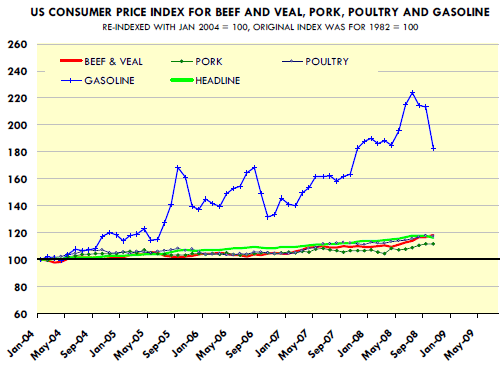



CME: How Long Before US Sees Price Decline?
US - CME's Daily Livestock Report for 20 November 2008.As energy, grain and other commodity prices decline from the spectacularly high levels established last summer, a question has been percolating in the popular press - how long before US consumers see a significant decline in meat prices?
It’s a reasonable question considering that crude oil prices are at $50 per barrel from almost $150 last summer and the price of corn, the main feedstock for US livestock and poultry producers, is down to $3.50 a bushel from near $8 last summer. But it is also a question that does not account for the full dynamics in the food market.
The reality of the matter is that it takes significantly longer for high raw material costs in the meat sector to translate in higher consumer prices than it does in many other industries. There are years between the time a calf is just a sparkle in some bull’s eye in the fields of Texas and the time a US consumer picks up a steak or some ground beef at the local supermarket. In some cases, such as with chicken, the industry was able to keep in check prices for items such as chicken breasts in order to keep market share and because some of the loses were offset by better returns in export markets.
But even more importantly, we propose that a good portion of the significant increase in food raw material costs (be this higher grain or meat prices) was absorbed by the various players in the supply chain and US consumers had actually seen a very small part of the increase. It is simply too difficult for food retailers and foodservice establishments to drastically change prices on the shelves or menus. Often they pushed back and some the rise in raw material costs was absorbed by suppliers in the form of tighter margins.
When cereal producers were faced with sharply higher wheat and corn prices last spring, they responded by reducing the pack size rather than actual prices for consumers (CPI numbers look at price per unit of serving, however). The chart is an update of the version we presented last year at around this time. It shows that while gasoline prices have risen sharply since January 2004, a result of the easy pass-through of costs in that industry, beef, pork and poultry price appreciation has actually been much more muted and very close to the overall headline inflation for this period. Will meat raw material prices ease going forward? The answer is yes. Will consumers see lower meat prices? Unlikely, given that they did not see a significant portion of the increase.









